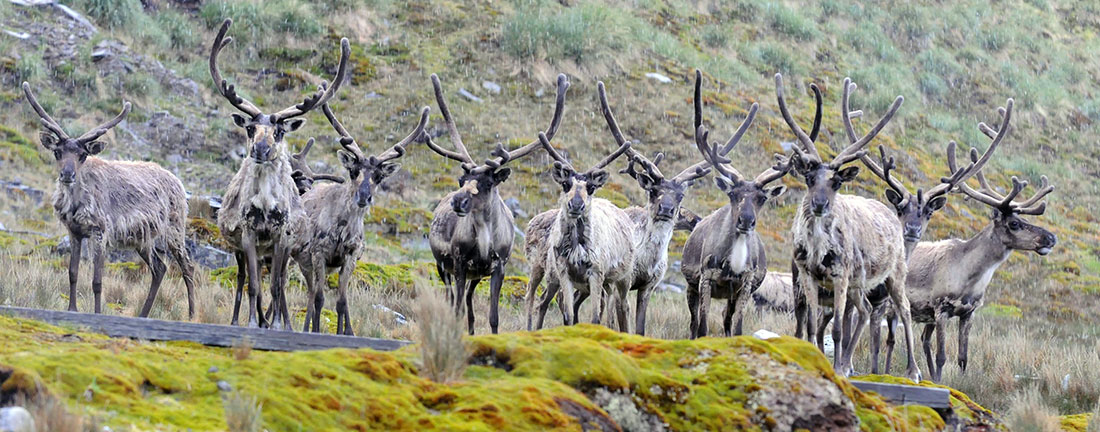Eradication Projects/Reindeer
Reindeer were introduced to South Georgia by Norwegian whalers in order to provide a familiar food source and to vary an otherwise limited diet. The reindeer were also a reminder of home, and hunting them provided a recreational activity. Reindeer were introduced to two discreet areas of South Georgia on three occasions between 1909-1925. Combined, the areas occupied by reindeer equate to the largest snow free, and consequently most biologically productive, part of the island. After their introduction, the reindeer herds were controlled through regular hunts. However, since the 1980s no hunting or management of the herd has occurred, and as a consequence the herds expanded substantially, to the point where nearly all available grazing habitat had been utilized.
Many plant communities on South Georgia have been overgrazed by reindeer, the most significant being tussac and burnet. Extensive overgrazing of tussac grassland is clearly evident on the island, most notably on ridge tops and raised coastal areas, where large areas are completely denuded. The removal of the vegetation cover and topsoil has negative consequences for native burrowing birds such as prions and petrels as nest entrances are exposed and burrows are more prone to collapse.
Following a long period of stakeholder consultation, in 2010 GSGSSI made the decision to remove reindeer from the Island.
The eradication was divided into two phases. The first saw the removal of reindeer from the Busen area, the second saw removal of reindeer from the Barff Peninsula and Royal Bay area.
The first phase of the reindeer eradication project was undertaken in the Busen area in January and February 2013. Following the recommendations of an advisory group on reindeer management methodology, and a reconnaissance trop in 2012, the decision was taken to trial a combination of herding and corralling and ground shooting to eradicate reindeer from this area. These two methods were thought to provide the best balance between the need to eradicate the reindeer in an efficient and humane manner, to remove the bulk of carcasses and to allow recovery of commercially viable products. The eradication team consisted of ten Sami reindeer herders, four marksmen, four science assistants, a vet, a doctor and two project management staff. Pharos SG was used as a support vessel and a seatruck was operated to move cargo and carcasses between ship and shore. The operation succeeded in gathering 989 animals (of which meat was recovered from 929) and shooting 1,012. A total of 7,685 kg of meat was recovered which has been sold to the cruise ship industry and local restaurants in the Falkland Islands. Marksmen were also were able to shoot 1,555 animals on the Barff Peninsula, reducing the population in readiness for the following year.
In early 2014 six Norwegian marksmen returned to South Georgia to complete the operation on the Barff Peninsula. The rugged terrain and lack of suitable anchorages on the Barff Peninsula meant that herding was not a viable option, so ground shooting was used as a stand-alone method. The marksman were based in tented field camps and supported by the GSGSSI fisheries patrol vessel the Pharos SG. Marksmen completed systematic searches of all areas with reindeer and shot 3,140 animals in a six-week period.
Relevant documents including reports and press releases can be found here.


